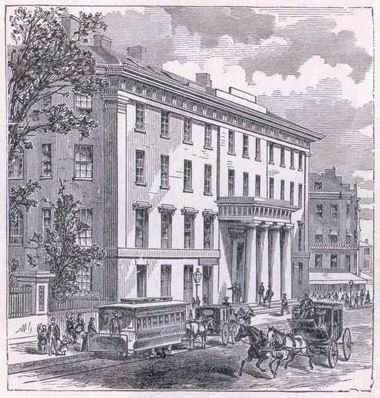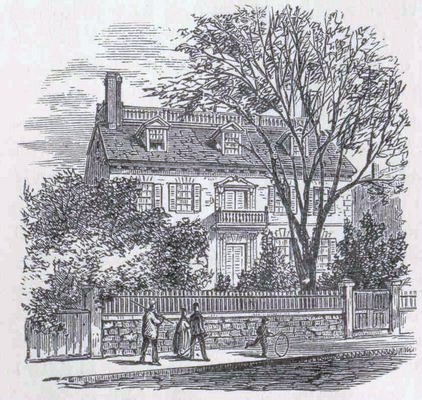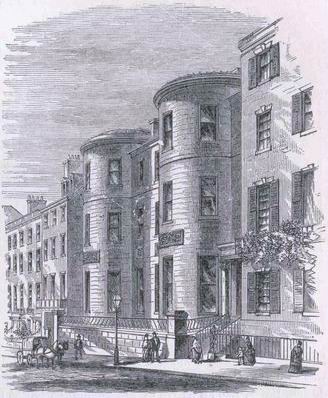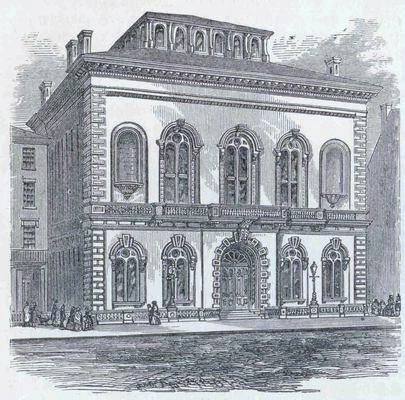|
1999-2003
|
|
1999-2003
|
|
The West End, Continued.
The Union Club was founded in the year 1863, for “the encouragement and dissemination of patriotic sentiment and opinion,” and the condition of membership was “unqualified loyalty to the Constitution of the Union of the United States, and unwavering support of the Federal Government in efforts for the suppression of the Rebellion.” Its organization is continued to promote social intercourse. The present club-house was formerly the residence of the late Abbott Lawrence. The membership, which is limited to six hundred, includes many of the best and wealthiest citizens of Boston. It has at present, however, no political character, and the condition pf membership quoted above has been removed. Directly north of the Granary Burying-Ground is the Tremont House, a hotel that has for a long time enjoyed a deserved reputation for the excellence of its accommodations and its cuisine. It occupies the corner of Tremont and Beacon Streets, with its main entrance on Tremont. Its front of granite is plain and devoid of ornamentation. I t was built in 1828—29 by a stock company organized for the purpose; but in 1859 it was purchased for the Sears estate. It was again sold in 1888.  Tremont House. It has been several times enlarged, and was thoroughly renovated and modernized during the autumn of 1885. This house received President Johnson as a guest when he visited Boston on the occasion of the dedication of the Masonic Temple in June, 1867. Years before, President Jackson was at one time its guest; also Henry Clay. And during his first visit to America Charles Dickens stayed here. The house is conducted on the American plan. The granite front building just beyond, on Beacon Street, occupying the corner of Beacon and Somerset Streets, is the Vatican of Congregationalism, and contains the offices of the denominational paper, the headquarters and museum of the American Board of Commissioners for Foreign Missions, the rooms of the Congregational Club, Pilgrim Hall, and the Congregational Library, a collection of over 25,000 volumes and 100,000 pamphlets in a handsome fire-proof hall. This structure was built just after the War of 1812, on the site of the first stone house in Boston, and was for a long time held by the Somerset Club. On Beacon at the corner of Bowdoin Street is the new Unitarian Building, completed in 1886, a notable addition to the denominational houses of Boston. It is of brown stone ornamented with tasteful carving. The inside is finished through.. out plainly in oak. The large halls are finished with the masonry in sight, and there are open fireplaces in all the different departments.  The Unitarian Building. To those for whom the sacred quietness and bookish odor of a great library have fascinating attractions this part of Boston is full of perennial interest. The buildings of the Boston Athenaeum and the New England Historic, Genealogical Society are in this neighborhood; and near by, on Tremont Street, is that of the Massachusetts Historical Society, described in the chapter on the Central District. The Athenaeum Building is at No. 10A Beacon Street. It is built of free-stone, in the later Italian style of architecture. It cost nearly $200,000, and was first occupied in 1849. Within it is a library, now containing over 220,000 volumes; and a reading-room. The scientific library of the American Academy of Arts and Sciences is also here, in the eastern room of the lower floor. The Athenaeum was incorporated in 1807, and had its origin in a magazine called the “Monthly Anthology,” first published in 1803. Soon after, a company of men zealous for literature organized the Anthology Club, and a public library and reading-room established by this club was the nucleus of the present institution. The right to use it is confined to the holders (and their families) of about 1,000 shares; but the management is very liberal towards strangers. There is an absence of “red tape” in the general direction of the library that makes it one of the most delightful literary homes to be found anywhere. An art gallery used to be a fine feature of the Athenaeum, but its contents were removed to the Museum of Fine Arts when that was established. A recent change in the vestibule has greatly increased the book room, while diminishing the proportions of the fine entrance hall.  Boston Athenaeum. The Historic, Genealogical Society’s building is the handsome stone structure at No. 18 Somerset Street. It contains a valuable library of about 16,000 volumes, and a rare collection of antiquities. The society was founded in 1844, and has about four hundred members, each of whom, after his election, gives a written account of his descent. Its chief object is the study and publication of historical and genealogical facts about New England and her people; and the results of its researches have been sent out in a number of goodly tomes. The collections here are accessible to all students of history, and are in constant use. The next house to that of the society, on the south, was the birthplace of Rear-Admiral C. H. Davis, who destroyed the Confederate fleet off Memphis, in 1862. Also on Somerset Street, near Beacon Street, is the new building of the Boston University, a great Methodist institution, founded in 1869, and richly endowed by Isaac Rich, consisting of a group of colleges and schools, attended by both sexes. There are large and successful schools of law, medicine, and theology connected with it, situated in different parts of the city, and a college of liberal arts. The present building was completed in 1882, at a cost of $80,000. It is built of pressed brick and terra-cotta. It contains the offices of the president and dean of the University and a meeting-room for the corporation; large class-rooms, a “young men’s study,” and a “young ladies’ study,” — the latter a most inviting apartment, tastefully decorated and agreeably furnished, —a University chapel, and a large hail for public exercises. The building is called “Sleeper Hall,” in honor of Jacob Sleeper, one of the founders of the institution. The Law School occupies a separate building near by, at No. 8 Ashburton Place. At the foot of the hill, on Howard Street, near Somerset, is the Howard Athenaeum, one of the oldest of the existing theatres in the city. It is now a “variety theatre,” but in. its day it has held a foremost place among the theatres presenting the “legitimate drama.” It was first opened October 13, 1845. On its boards the eminent comedian, William Warren, for years at the head of his profession, made his first appearance in Boston, in 1845. The theatre occupies the site of the Tabernacle erected by the “Millerites” in 1843-44. Returning to Beacon Street the stranger will observe on the low fence in front of one of the stately brown-stone houses just beyond the State House a tablet which announces that here once stood the Hancock Mansion, one of the most famous of the old buildings of Boston that have been compelled to make way for modern improvements. This house was in itself and in its surroundings one of the most elegant mansions in the city, though the style of architecture had wholly gone out of fashion long before it was taken down. It was built by Thomas Hancock in 1737, and was inherited by Governor John Hancock. Both uncle and nephew were exceedingly hospitable, and were accustomed to entertain the Governor and Council and other distinguished guests annually on “Artillery Election Day ;“ and it is said that every Governor of Massachusetts under the Constitution, until the demolition, was entertained once at least within this mansion. The house was taken down in 1863.  The Old Hancock House. The Somerset Club was organized in the year 1852, having grown out of another organization known as the Tremont Club, and is now, as it has always been since it took its present name, a club for purely social purposes. The membership is limited to six hundred. As has already been stated the Somerset Club occupied until the year 1872 the mansion at the corner of Somerset and Beacon Streets, now known as the Congregational House. At that time the club purchased its present house, a magnificent granite - front mansion. This house was built by the late David Sears, Esq., for a private residence. The club found it necessary to make little alteration in the arrangement of the rooms, but it has thoroughly refitted and furnished them, and added other buildings. On the slope of the hill, a short distance below the Somerset Club-house, and nearly opposite the foot of the Common, stands the dwelling-house occupied by Mr. Ticknor’s friend, the historian Prescott, during the last fourteen years of his life. It is unpretentious in architecture, but it was fitted within in a style of great elegance, and was arranged specially with reference to Mr. Prescott’s infirmity of partial blindness. Here the greater part of the work on his histories of the Spanish conquests was done. To this house he removed, in 1845, from his former home in Bedford Street, and in it he died in 1859.  Beacon Street.—The Somerset Club. Across the Common, on Boylston Street, which bounds it on the south, is the Boston Public Library, one of the most beneficent institutions that has been conceived by the public-spirited and liberal citizens of Boston. The immense collection constituting this library, which has been gathered rapidly since its establishment, is valuable not only from the variety, excellence, and number of volumes it contains, but from its accessibility. It is absolutely open to all, and no assessment, direct or indirect, is levied upon those who make use of its privileges. Citizens and residents of Boston only, however, are allowed to carry books away from the building. The library is conducted on the most liberal principles. If a purchasable book not in the library is asked for, it is ordered at once; and the inquirer for it is notified when it is received. Although the idea of a free public library had been entertained much earlier, it was not until 1552 that this institution was actually established. Very soon after the board of trustees was organized, Joshua Bates, Esq., a native of Massachusetts, but at that time of the house of Baring Brothers & Co., of London, gave to the city the sum of fifty thousand dollars, the income of which he desired should be expended in the purchase of books. The upper hail of the library building has been named Bates Hall in compliment to him. Generous donations and bequests by many wealthy and large-hearted men and women from time to time have swelled the permanent fund of the institution to upwards of $ 100,000. Several valuable private collections have been acquired by the library. In 1871 the library of Spanish and Portuguese books and manuscripts belonging to the late George Ticknor, Esq., were placed in the library, in accordance with his will. This alone added more than 4,000 volumes and manuscripts to the library. In 1873 the famous Barton Library of New York, numbering about 12,000 volumes, one of the finest private libraries in the country, and especially rich in Shakespearean literature, was purchased. The library of Theodore Parker, numbering over 11,000 volumes, and that of Nathaniel Bowditch of about 2,500, have been added to the general collection, the former received under the will of Mr. Parker and the latter given by Mr. Bowditch’s children; and the valuable historical and theological collection, forming the famous Prince Library, bequeathed by Mr. Prince to the Old South, is deposited in the Library and is accessible to scholars and others conditionally. Large additions to the general library are made yearly, and it now numbers more than 450,000 volumes, and over 200,000 pamphlets. The annual circulation amounts to about 1,300,000 separate issues. Thus this library is the first in the country in the number of issues and is superior in number of volumes to the Library of Congress. It has been in its present quarters since 1858, and several years ago outgrew the original capacity of the building. Various devices have since been resorted to in order to accommodate the large number of new volumes added annually. In 1880 land was given by the Commonwealth for a new library building, and this having been formally accepted by the city, a new structure is now in process of erection. The new location is in the Back Bay district, occupying an entire lot on Boylston and Dartmouth Streets, and Copley Square. Branches of the Boston Public Library have been opened in East and South Boston, the South End and North End of the city proper, Roxbury, and Dorchester districts, while the libraries of Charlestown and Brighton became branches by annexation. These branches have from ten to twenty-five thousand volumes each. The reading-room in the main or central library building is open every day in the week, including Sundays.  Boston Public Library. The building adjoining the Public Library building, on the corner of Boylston and Tremont Streets, is the Hotel Pelham, the first apartment house, or “family hotel” on the “French flat” system, erected in the city. This was built about thirty years ago, and since its establishment the apartment-house system has been quite extensively introduced into Boston, a large number of costly and elegant apartment houses and family hotels having been erected within recent years. The Hotel Pelham is distinguished in its neighborhood as a building which has been successfully moved several feet without the slightest disturbance to its occupants. When Tremont Street was widened in 1869 this large structure was raised bodily and moved back about twenty feet. A few doors below the Public Library building, on Boylston Street, is the Central Club-house. This club was formerly a South End club, and its first club-house was on the corner of Washington Street and Worcester Square. Its present quarters were formerly occupied by the Art Club, and were leased after the removal of the latter club to its new club-house in the Back Bay district, — to be referred to in the description, to follow, of this district. The Central Club was organized in 1869, and its present membership is large. Near by the Central Club-house are those of the Whist, Electric, and Tavern Clubs, social organizations formed within recent years. In Park Square, just off Boylston Street, nearly opposite the Providence Railroad Station, is the group of statuary known as the “Emancipation Group,” commemorating the emancipation of the slaves by President Lincoln. The group was designed by Thomas Ball, in 1865. In 1873, a colossal copy of the same group was made for the “Freedmen’s Memorial,” at Washington. The face of the negro was a likeness of the last slave remanded to the South under the fugitive slave law, studied from photographs. The group now in Boston was presented to the city by the Hon. Moses Kimball, a public-spirited citizen, who long lived on Boylston Street nearby. It stands on a small triangular plat, and is surrounded by a granite retaining-wall and bronze railing, the pedestal being formed by two steps of Cape-Ann granite, and an octagonal block of polished red granite weighing sixteen tons. The bronze was cast at Munich and cost $17,000. The height of the entire work is nearly twenty-five feet. It was unveiled December 6, 1879. The station of the Boston and Providence Railroad, although surpassed in size by a few structures of the kind, is inferior to none, in this country at least, in artistic beauty and in adaptability to the uses for which it was designed. It consists of two distinct but connected parts. The train-house has a length of five hundred and eighty-eight feet and an extreme width of one hundred and thirty feet. The great iron trusses cover five tracks and three platforms. The head-house is two hundred and twelve feet long, and one hundred and fifty feet wide at the widest point, the lot on which it stands being very irregular in shape. In the centre of the head-house is a great marble hall, one hundred and eighty feet long, forty-four broad, and eighty high. It is imposing in its general effect and magnificent in its architectural beauty and its ornamentation. Surrounding this hall are the waiting and other rooms for the accommodation of passengers, a periodical stand, baggage and package rooms, and an excellent restaurant. A barber-shop is attached to the news-room. A fine gallery surrounds the hall above mentioned, and from this access is had to the offices of the company and other apartments. The cost of this station was nearly one million dollars. The Providence Railroad has numerous branches, and its main line forms part of the popular Shore (all rail) and Stonington (rail and steamboat) lines to New York. It was united with the Old Colony in 1888, and is now operated as the Providence division of the Old Colony system. In the immediate vicinity of the Providence station is the tract known as the Church Street district, where one of the most beneficial enterprises the city has ever undertaken has been carried out within a few years. The district was low, marshy, and unhealthy, but it was covered with permanent buildings. The city undertook to raise the whole district, and this it did at an expense of about a million dollars. In the course of this operation nearly three hundred brick buildings were raised, some of them fourteen feet, and the whole territory was filled in to a uniform height. Between the Providence station and the Public Garden, and facing the latter on Boylston Street, is the new Hotel Thorndike, a fine structure of brick and freestone, admirably situated, and conducted on the European plan. At No. 2 Newbury Street, a few doors from Arlington Street and the Public Garden, is the club-house of the St. Botolph Club, which was formed in 1880. It includes many of the foremost citizens of Eastern Massachusetts, and is the leading professional club in the city. The St. Botolph Club possesses a fine art gallery, and gives private exhibitions occasionally during the season. Francis Parkman, the historian, was the first president of the club. |